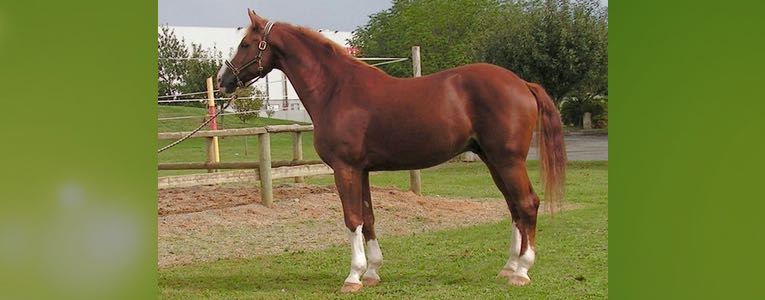
Use of ozone therapy in chronic laminitis in a horse.
Abstract
Keywords
References
Baxter G. M. Acute laminitis. Vet Clin. North Am. Equine Pract. 1994;10(3):627-642.
Martins-Filho LP, Fagliari JJ, Moraes JRE, Sampaio RC, Oliveira JA, Lacerda-Neto JC. Estudo clínico e laboratorial da fase prodrômica da laminite equina induzida por sobrecarga de carboidrato. ARS Veterinária. 2007;23(1):32-39.
Moore JN, Allen D, Clark S. Pathophysiology of acute laminitis. Vet Clin North Am. Equine Pract. 1989;5(1):67-72.
Stashak T. Claudicação em Equinos segundo Adams. 5 ed. São Paulo: Roca; 2006.
Johnson PJ, Messer NT, Slight SH, Wiedmeyer C, Buff P, Ganjam VK. Endocrinopathic Laminitis in the Horse. Clinical Techniques in Equine Practice. 2004;3:45-56.
Johnson PJ, Kreeger JM, Keeler M, Granjam VK, Messer NT. Serum markers of lamellar basement membrane degradation and lamellar histopathological changes in horses affected with laminitis. Equine Veterinary Journal. 2000;32(6):462-468.
Moyer W, Schumacher J. Chronic Laminitis: Considerations for the Owner and Prevention of Misunderstandings. In: AMERICAN ASSOCIATION OF EQUINE PRACTITIONERS CONFERENCE, 46. 2000. Proceedings of the 2000 AAEP. San Antonio: AAEP; 2000.
Bocci V. Ozone: A new medical drug. 2nd ed. Heidelberg: Springer; 2006.
Buric J, Molino-Lova R. Ozone chemonucleolysis in non-contained lumbar disc herniations: a pilot study with 12 months follow-up. Acta Neurochir Suppl. 2005;92:93-97.
Ying WZ, Jiang CM, Wang ZM. Percutaneous treatment of lumbar disc herniation by oxygen-ozone injection: A clinical study of 322 case. Rivista Italiana di Ossigeno-Ozonoterapia. 2005;4(1):6-8.
Hunt RJ. Laminitis in the geriatric horse. Veterinary Clinics of North America. Equine Practice. 2002;18(3):439-452.
Oliveira-Jr J, Lages GV. Ozonioterapia em lombociatalgia. Revista Dor. 2012;13(3):261-270.
Dowling P. Myths and Truths About Controlling Pain and Inflammation in Horses. In: Agriculture and Rural Development [Internet], 2011. Available from: http://www1.agric.gov.ab.ca/$department/deptdocs.nsf/all/hrs3708
Iliakis E, Valadakis V, Vynios DH, Tisiganos CP, Agapitos E. Rationalization of the activity of medical ozone on intervertebral disc: a histological and biochemical study. Rivista di Neuroradiologia. 2001;14:23-30.
Bocci V, Luzzi F, Corrasdeschi F, Paulesu L, Di-Stefano A. Studies on the biological effects of ozone. III. An attempt to define conditions for optimal induction of cytokines. Lymphokine Cytokine Res. 1993;12(2):121-126.
Steppan JC, Boxley MK, Muto M, Balagurunathan K, Meaders T. Ozone mechanism of action for relieving pain associated with herniated intervertebral discs. J. Vasc. Interv. Radiol. 2009;20(2):16-17.
Friedman M, Madden MC, Samet JM, Koren HS. Effects of ozone exposure on lipid metabolism in human alveolar macrophages. Environ. Health Perspect. 1992;97:95-101.
Bulies JCE, Diaz OV, Rauder RS, Valdez YL, Garcia CL. Resultados terapeuticos en osteoartritis de la rodilla con infiltraciones de ozono. Rev. Cubana Invest. Biomed. 1997;16(2):124-132.
Bulies JCE. Una solucion para exposiciones oseas postraumáticas: asociacion de injerto de epiplon mayor com ozonoterapia. Rev. Cubana Invest. Biomed. 1996;15(2):1-9.
Bonetti M, Fontana A, Cotticelli B, Volta GD, Guindani M, Leonardi M. Intraforaminal O2-O3 versus Periradicular Steroidal Infiltrations in Lower Back Pain: Randomized Controlled Study. American Journal of Neuroradiology. 2005;26(5):996-1000.
O'Grady SE. Realignment of P3 – the basis for treating chronic laminitis. Equine Veterinary Education. 2006;18(4):214-218.
White N. Equine laminitis. In: The Waltham International Nutritional Science Symposium, 2005. Available from: https://www.vetmed.vt.edu/emc/welcome/bios/white/equine_laminitis.pdf
Redden RF. Shoeing the Laminitic Horse. In: AMERICAN ASSOCIATION OF EQUINE PRACTITIONERS CONFERENCE, 43. 1997. Proceedings of the 1997 AAEP. Phoenix: AAEP; 1997.
Parks AH. Chonic laminitis. In: Robinson NE. eds. Current therapy in equine medicine. St. Louis: Saunders; 2003.
O'Grady SE. Farriery for Chronic Laminitis. Veterinary Clinics of North America Equine Practice. 2010;26(2):407-423.
Belknap J. Treatment of the Chronic Laminitis Case. In: NORTH AMERICA VETERINARY CONFERENCE, 20. 2006. Proceedings of the 2006 NAVC. Orlando: NAVC; 2006.
Shallenberguer F. Principles and applications of Ozone therapy: A practical guideline for physicians. Kentucky: CreateSpace Independent Publishing Platform; 2011.
Refbacks
- There are currently no refbacks.
![]() Journal of Ozone Therapy (JO3T)
Journal of Ozone Therapy (JO3T)
The Official Peer Reviewed Journal of the World Federation of Ozone Therapy (WFOT)
ISSN 2444-9865
